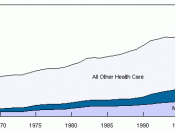Medicaid. It is the United States Federal Government program to aid states in providing health care to the poor and impoverished who otherwise could not receive proper medical care. In 1995 the federal government spent a total of $77.4 Billion on Medicaid. This is up almost 300 percent from $20.1 Billion in 1984, only 10 years earlier. In the same 10 years state spending on Medicaid rose over 250 percent from $16.5 Billion to $58.2 Billion. Under the current Medicaid programs, Medicaid spending will increase at an annual rate of 10 percent, to an estimated $262 Billion by the year 2002.
Medicaid spending has grown much faster than the general rate of inflation. For the Federal Government, Medicaid expenditures have grown from only 1 percent of the national budget in 1970 to over 6 percent in 1995, while state expenditures went from 8.1 percent to 13.5 percent in the same time span.
This increase can be attributed to multiple factors. First, through a series of mandates, the Federal Government has expanded the eligibility for Medicaid, requiring states to serve more people. They also increased the standards required of nursing homes. This led to higher nursing home costs which were passed directly back to the Medicaid program. The current average cost to care for a patient in a nursing home is nine times greater than that of a single dependent child. The price of medical care, in general, has drastically increased. Expensive new technology and procedures are a large part of this increase. The need for these costly new technologies is not expected to decrease, the cost will just be passed on to the public through higher prices and higher Medicaid spending. And finally, an estimated 10 percent of Medicaid payments is wasted on fraud. This is mostly...


